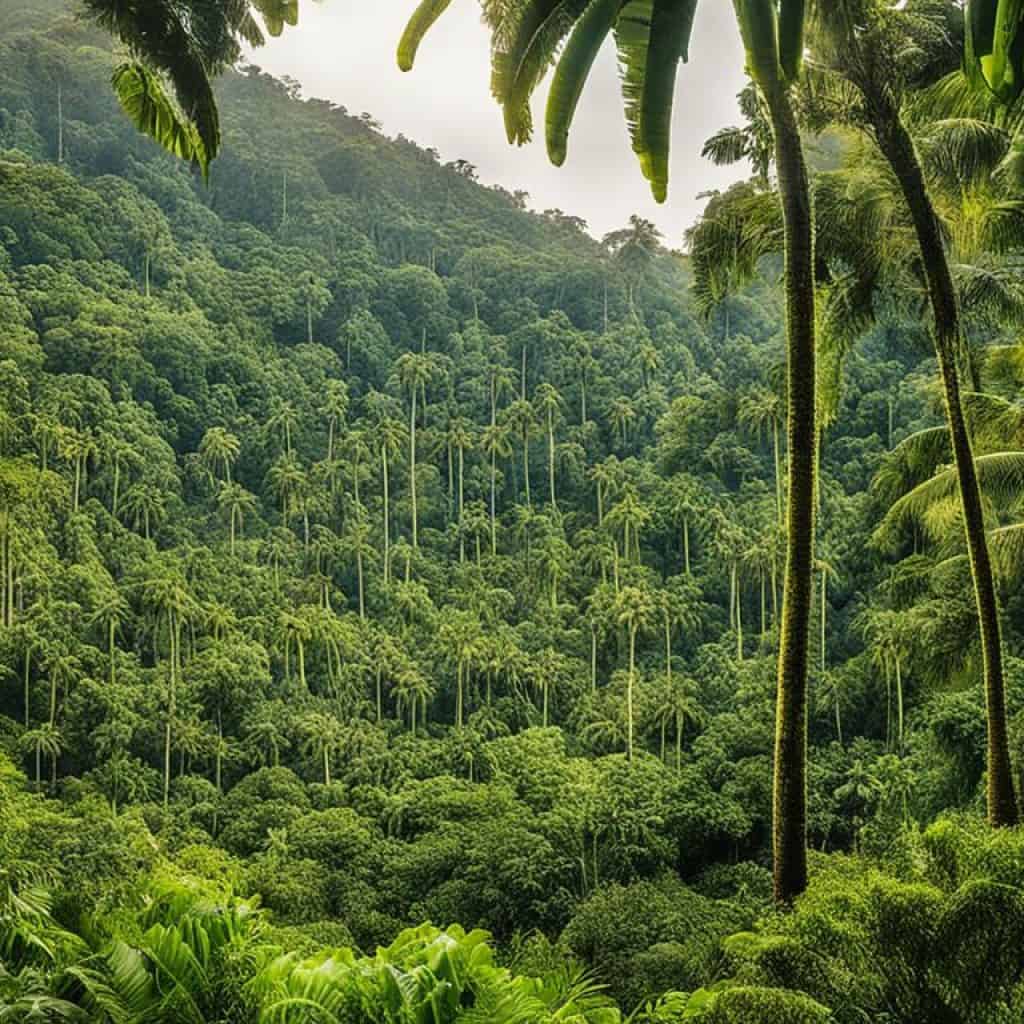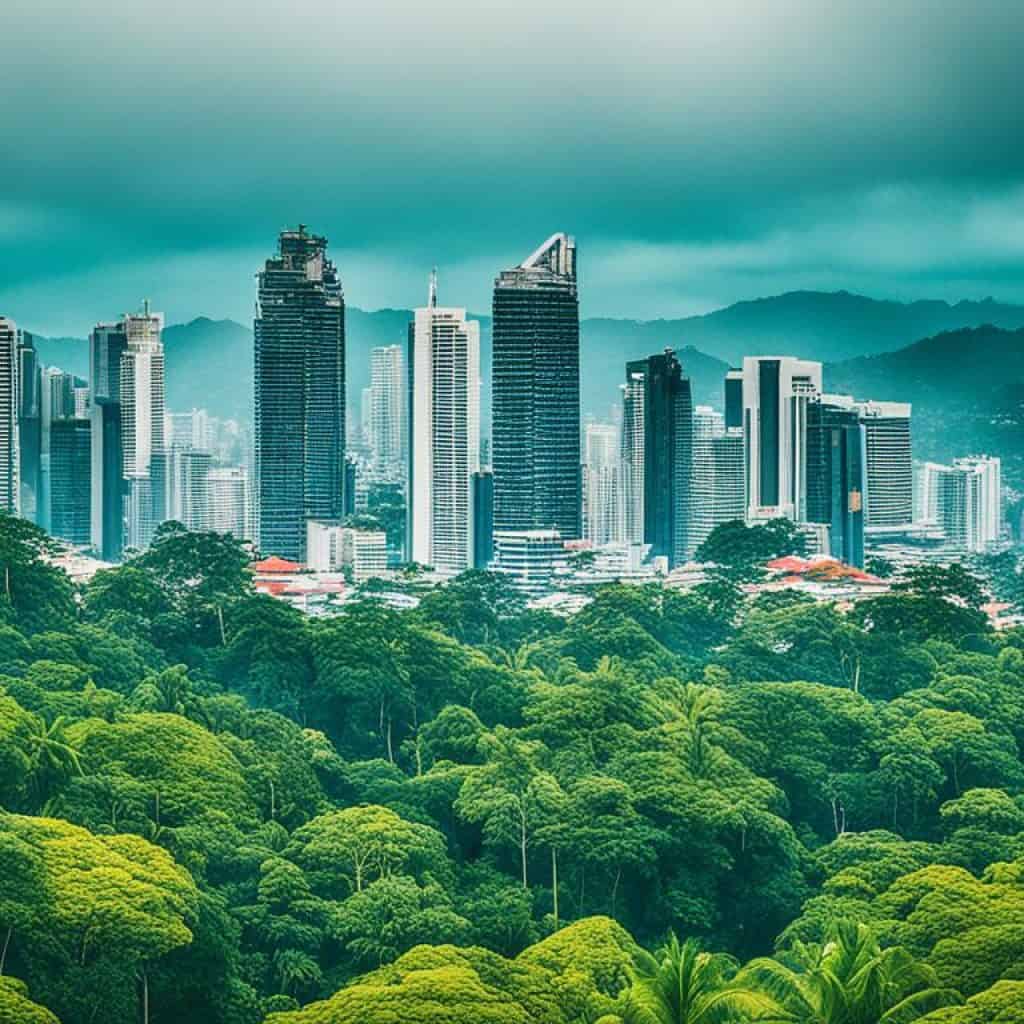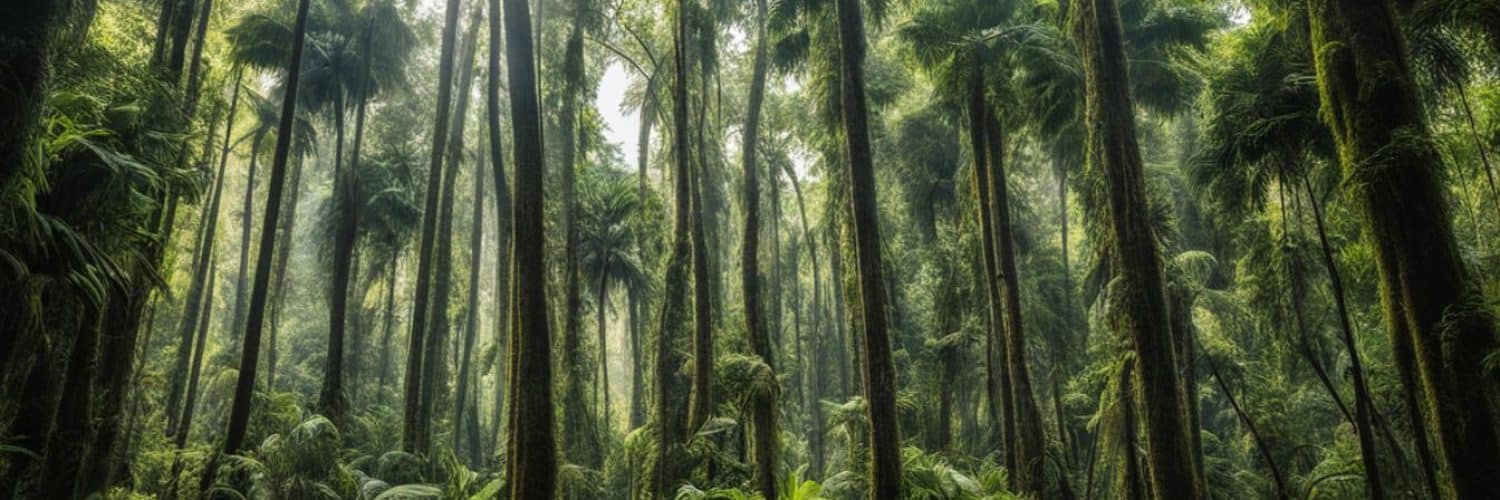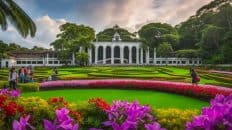Have you ever wondered about the incredible diversity of trees that thrive in the Philippines? From towering giants to delicate blossoms, the Philippine forests are home to an astonishing variety of tree species. With its unique geographical features and tropical climate, the Philippines boasts a rich natural heritage that is worth exploring. But how many types of trees are there in the Philippines? And what makes them so special? Let’s embark on a journey to discover the diverse types of trees in the Philippines and unravel the secrets they hold.
Key Takeaways
- The Philippines is a megadiverse country with a wide range of tree species.
- The country is home to both native and non-native trees.
- Fruit-bearing trees, such as mango and coconut, are notable in the Philippines.
- Trees in the Philippines have significant environmental, cultural, and economic importance.
- Conservation efforts and native tree planting initiatives play a crucial role in preserving the country’s natural heritage.
Native Trees of the Philippines
The Philippines is blessed with a rich diversity of native trees that are found exclusively in the country. These indigenous trees are not only unique and captivating but also play a crucial role in maintaining the delicate balance of the Philippine ecosystem.
Among the remarkable examples of native trees in the Philippines are:
- Millettia pinnata: A majestic tree with vibrant purple flowers. It is known for its valuable timber and medicinal properties.
- Bombax ceiba: Also known as the silk cotton tree, it stands tall with large flowers and a distinctive trunk. It is highly regarded for its timber and is an important part of Philippine folklore.
- Lagerstroemia speciosa: Commonly known as the banaba, this tree showcases beautiful pink flowers and has significant medicinal benefits, particularly in traditional Philippine medicine.
- Dillenia philippinensis: Known as the katmon tree, it features large white flowers and a sour fruit. The tree is cherished for its ornamental value and is often used in landscaping.
- Cananga odorata: Also known as the ylang-ylang tree, it bears fragrant yellow flowers that are commonly used in perfumes. It is highly valued for its essential oil.
- Vitex parviflora: Commonly called the lagundi tree, it is recognized for its medicinal properties and is often used to treat respiratory ailments.
- Pterocarpus indicus: Referred to as the narra tree, it is the national tree of the Philippines and is admired for its stunning red flowers and high-quality timber.
These Philippine native trees contribute not only to the beauty of the landscape but also to the country’s cultural and ecological heritage. They provide habitats for a diverse range of wildlife, contribute to the preservation of biodiversity, and support sustainable forestry practices.
Non-Native Trees in the Philippines
In addition to the diverse array of native trees in the Philippines, the country also boasts a variety of non-native or exotic trees that have been introduced from different parts of the world. These exotic trees bring their unique characteristics and benefits, contributing to the country’s rich tree diversity and supporting various environmental initiatives.
Rapid Growth for Reforestation: Gmelina
One exceptional fast-growing tree species in the Philippines is the Gmelina tree. With its rapid growth rate, Gmelina has become a valuable asset in reforestation efforts. It is commonly planted in areas that have experienced deforestation, helping to replenish forest cover and restore ecological balance.
Precious Timber: Philippine Mahogany (Lauan)
The Philippine mahogany, also known as Lauan, is a non-native tree species that has gained popularity for its valuable timber. This versatile hardwood is highly sought after in the timber industry and is utilized for various applications, including furniture, flooring, and construction.
Shade and Ornamentation: Ipil and Yakai
The Ipil and Yakai trees are examples of exotic trees in the Philippines that provide both shade and aesthetic beauty. These trees are often planted in parks, gardens, and urban areas, where their lush foliage and vibrant flowers lend a touch of elegance to the surroundings.
Natural Beauty: Philippine Teak
The Philippine Teak is another captivating non-native tree species found in the country. Known for its stunning golden blooms, this tree adds a touch of natural beauty to landscapes and is often admired for its aesthetic appeal.
These exotic trees have successfully acclimated to the Philippine environment and continue to thrive, contributing to the country’s diverse forestry and supporting various ecological endeavors.
Discover the unique characteristics and benefits of non-native trees in the Philippines, including the fast-growing Gmelina, valuable Philippine mahogany, ornamental Ipil and Yakai, and the natural beauty of Philippine Teak.
Fruit-Bearing Trees in the Philippines
The Philippines is renowned for its delicious tropical fruits, and these delectable treats are sourced from the various fruit-bearing trees found across the country. Two iconic fruit-bearing trees that hold significant prominence are the Mango tree and the Coconut tree.
The Mango tree, scientifically known as Mangifera indica, is celebrated for its succulent and juicy mangoes. This tropical tree is esteemed for producing a wide variety of mango cultivars, each with its own unique flavor and texture. From the vibrant yellow Carabao mango to the luscious Guimaras mango, these fruits are a favorite among locals and foreigners alike.
Another fruit-bearing tree that plays a pivotal role in Philippine culture and cuisine is the Coconut tree, or Cocos nucifera. This majestic tree holds great cultural significance and provides not only the delicious coconuts themselves but also various valuable byproducts. The coconut oil extracted from its fruit is a versatile ingredient used in cooking and skincare, while coconut water offers a refreshing and hydrating beverage. The tree also yields coir fiber, which is used for making ropes, mats, and various other products.
These fruit-bearing trees contribute not only to the country’s vibrant food industry but also to the livelihood of many Filipinos engaged in fruit cultivation and processing. They embody the tropical essence of the Philippines and are key players in the country’s culinary heritage.
“The Mango tree and the Coconut tree are iconic fruit-bearing trees that symbolize the abundance and diversity of tropical fruits in the Philippines.”
Embrace the delectable flavors and refreshing goodness that these fruit-bearing trees offer, and explore the culinary delights that make the Philippines a tropical paradise.
Mango Tree Varieties in the Philippines
The mango tree family boasts an array of exquisite varieties, each with its own distinct characteristics. Here are a few popular mango cultivars found in the Philippines:
| Mango Variety | Description |
|---|---|
| Carabao Mango | This is the most famous mango variety in the Philippines, known for its large size, vibrant yellow color, and sweet, tangy flavor. |
| Pico Mango | Also called “champagne mango,” this variety is smaller in size but bursts with a rich, honey-like taste and smooth texture. |
| Guimaras Mango | Hailing from the island of Guimaras, this mango is hailed as one of the best mango varieties worldwide. It is known for its sweet, juicy flesh and thin seed. |
| Maharlika Mango | This mango variety is distinctive for its elongated shape, bright yellow skin, and exceptionally sweet taste. |
These mango varieties are just a sample of the many delightful fruits that thrive on the branches of mango trees throughout the archipelago.
Coconut Tree and its Versatile Products
The Coconut tree is not just a source of coconut fruit; it offers various valuable byproducts that have become an integral part of Philippine culture and everyday life.
| Coconut Product | Usage |
|---|---|
| Coconut Oil | Used in cooking, baking, skincare, and haircare products. |
| Coconut Water | A refreshing and hydrating beverage packed with essential electrolytes. |
| Coconut Milk | A thick, creamy liquid extracted from grated coconut flesh, commonly used in Philippine dishes such as curries and desserts. |
| Coconut Husk & Coir Fiber | Used for crafting ropes, mats, doormats, soil erosion control, and horticultural purposes. |

The Coconut tree’s versatility and the abundance of its products have earned it the title of the “tree of life.” It sustains not only the appetites of Filipinos but also numerous industries and crafts that rely on its various components.
Environmental Benefits of Trees in the Philippines
The trees in the Philippines are not only a breathtaking sight but also provide numerous environmental benefits. These majestic beings contribute significantly to the overall well-being of the country, playing a crucial role in mitigating climate change, preserving biodiversity, and managing water resources.
Carbon Sequestration and Improved Air Quality
Trees act as natural carbon sinks, absorbing carbon dioxide from the atmosphere through a process called carbon sequestration. They store the carbon in their trunks, branches, and leaves, allowing them to remove harmful greenhouse gases from the environment. As a result, trees in the Philippines play a vital role in combatting global warming and reducing the impact of climate change.
“Trees are the lungs of the Earth, purifying the air we breathe and providing us with the oxygen we need to thrive.” – Anonymous
In addition to carbon sequestration, trees also release oxygen during the process of photosynthesis, improving air quality and creating a healthier environment for both humans and wildlife. Their presence can help reduce air pollution, particularly in urban areas where industrial activities and vehicular emissions can be high.
Biodiversity and Habitat Preservation
The Philippines is renowned for its incredible biodiversity, and trees are a crucial component of this rich ecosystem. They provide diverse habitats for numerous plant and animal species, contributing to the preservation of biodiversity. The complex structure, shade, and resources offered by trees support the survival of various organisms, from insects to birds to mammals.
Preserving and planting trees helps protect the natural habitats of these species, ensuring their continued existence and promoting the overall health of the ecosystem. By safeguarding biodiversity, trees play a vital role in maintaining ecological balance and fostering a sustainable environment.
Water Management and Soil Stabilization
Trees in the Philippines also play a critical role in water management. Their root systems help prevent soil erosion by anchoring the soil and preventing it from being washed away by heavy rains or strong currents. This essential function helps protect against landslides and maintains the stability of slopes.
Moreover, the canopy of trees slows down rainfall, allowing water to be absorbed more efficiently into the ground. This process aids in groundwater recharge and reduces the risk of flooding. Trees also act as natural filters, purifying water by trapping sediments and absorbing pollutants before they reach water bodies.
| Environmental Benefits of Trees in the Philippines |
|---|
| Carbon sequestration |
| Improved air quality |
| Biodiversity preservation |
| Habitat creation |
| Soil stabilization |
| Water management |
Embracing the environmental benefits of trees in the Philippines allows us to appreciate their true value beyond their natural beauty. By recognizing their ability to combat climate change, support biodiversity, and manage water resources, we can actively contribute to a sustainable and thriving future for both nature and ourselves. Planting and protecting trees is a small, yet significant, step towards creating a greener and healthier Philippines.
Cultural and Historical Importance of Philippine Trees
Philippine trees hold great cultural and historical significance. Embedded within Filipino folklore and traditions, these native trees have become integral to the country’s identity and heritage. Each tree has its own unique symbolism, representing various attributes and stories cherished by the Filipino people.
Narra Tree: Strength and Resilience
One of the most revered trees in the Philippines is the Narra tree. Known for its dense and durable wood, the Narra tree is associated with strength and resilience. It has been used for centuries in the construction of houses, furniture, and even musical instruments. This iconic tree symbolizes the indomitable spirit of the Filipino people, standing tall amid challenges and adversity.
Balete Tree: Supernatural Beliefs
The Balete tree holds a mystic allure in Philippine folklore. Believed to be the dwelling place of supernatural beings, this tree is both respected and feared. Many Filipinos tell tales of mythical creatures or spirits lurking within the shadows of the Balete tree. These stories serve as cautionary reminders of the unseen forces that exist in the natural world, instilling a sense of respect for nature.
“The tales passed down through generations depict the Balete tree as a gateway to the spirit realm, where encounters with otherworldly beings may occur.”
Molave and Acacia Trees: Historical Significance
The Molave and Acacia trees hold historical significance in the Philippines. These trees have witnessed pivotal events and symbolize the Filipino people’s resistance against colonial powers.
The mighty Molave tree stands as a monument to the Filipino soldiers who fought for independence during the Philippine Revolution against Spanish colonization. This tree serves as a constant reminder of the bravery and determination of the Filipino people in their quest for freedom.
The Acacia tree, with its striking beauty and sturdy nature, has become a symbol of resilience and unity. It was under the shade of an Acacia tree in Balangiga where Filipino revolutionaries launched a surprise attack against American forces during the Philippine-American War. This event echoes the Filipino people’s unwavering spirit and their relentless fight for independence.
As these examples demonstrate, trees in the Philippines carry deep cultural and historical significance, intertwined with the rich tapestry of folklore and heritage. They serve as reminders of the strength, resilience, and unwavering spirit of the Filipino people throughout history.
Conservation Efforts for Philippine Trees
The Philippines is dedicated to safeguarding its diverse tree species and preserving its rich natural heritage. Through a combination of government initiatives, laws and regulations, and active participation from non-governmental organizations and local communities, significant strides are being made in tree conservation and reforestation efforts.
One of the key approaches to tree conservation in the Philippines is the establishment of protected areas and national parks. These areas serve as sanctuaries for various tree species, safeguarding their habitats and promoting biodiversity. Protected areas such as Mount Hamiguitan Range Wildlife Sanctuary and Puerto Princesa Subterranean River National Park play a crucial role in preserving the country’s unique flora and fauna.
Laws and regulations have been put in place to combat deforestation and prevent illegal logging. The Philippine Clean Air Act and the Forest Management Bureau’s Forest Protection and Law Enforcement Division work together to enforce strict measures against activities that harm the country’s forests and trees. These measures include the imposition of fines and penalties for illegal logging, as well as the implementation of sustainable forestry practices.

“The best time to plant a tree was 20 years ago. The second best time is now.” – Filipino Proverb
Reforestation plays a vital role in rebuilding and restoring the country’s forest cover. Tree planting initiatives, both organized by the government and supported by non-governmental organizations, aim to replenish deforested areas and promote sustainable forestry practices. Reforested areas contribute to carbon sequestration, enhance wildlife habitats, and protect watersheds, ultimately preserving the ecological balance.
To raise awareness about the importance of tree conservation and reforestation, various advocacy campaigns are carried out by non-governmental organizations and local communities. Educational programs, workshops, and community outreach events help disseminate information and encourage individuals to participate actively in tree planting and preservation efforts.
The Philippine Tree Conservation Progress:
| Conservation Efforts | Impact |
|---|---|
| Establishment of protected areas and national parks | Preserves habitats and promotes biodiversity |
| Enforcement of laws and regulations | Prevents deforestation and illegal logging |
| Reforestation initiatives | Restores forest cover and promotes sustainable forestry |
| Educational programs and advocacy campaigns | Raises awareness and encourages active participation |
By prioritizing tree conservation, the Philippines strives to ensure the preservation and sustainability of its valuable tree species. Tree planting, protected areas, and sustainable forestry practices are key ingredients in securing a greener and more eco-friendly future for generations to come.
Importance of Planting Native Trees
Prioritizing the planting of native trees is crucial for maintaining ecological balance and preserving the natural heritage of the Philippines. Native trees have adapted to the local ecosystem and provide specific benefits to the environment and wildlife.
Planting native trees plays a vital role in restoring and maintaining the delicate ecological balance in the Philippines. These trees have coevolved with the local flora and fauna, establishing a harmonious relationship that supports the survival of various species and contributes to overall biodiversity.
By planting native trees, we help ensure that the natural heritage of the Philippines remains intact for future generations to enjoy. These trees provide critical habitats for endangered and endemic species, supporting the preservation of the country’s unique and diverse wildlife.
Furthermore, native trees promote sustainable forestry practices in the Philippines. Due to their adaptability and resilience, these trees require fewer resources and interventions compared to non-native species. This reduces the need for excessive maintenance and allows for a more organic and self-sustaining ecosystem.
Supporting initiatives that focus on planting native trees contributes to a more sustainable future for the country. By participating in reforestation projects and advocating for the preservation of native tree species, we actively contribute to the restoration of degraded areas and the protection of our natural resources.
Together, we can ensure that the ecological balance of the Philippines is maintained, protecting the fragile ecosystems that provide numerous benefits, such as clean air and water, carbon sequestration, and natural beauty.
The Benefits of Planting Native Trees:
- Preserves biodiversity and habitats for endangered species.
- Contributes to sustainable forestry practices.
- Reduces the need for excessive maintenance and interventions.
- Restores degraded areas and improves ecosystem health.
- Enhances air and water quality.
- Supports carbon sequestration and mitigates climate change.
The Role of Trees in Philippine Economy
Trees in the Philippines have a significant economic importance, contributing to various industries and job opportunities throughout the country.
The timber industry in the Philippines heavily relies on the valuable resources provided by trees, particularly the Philippine mahogany. This sought-after timber is exported, generating revenue and supporting the local economy.
Fruit-bearing trees also play a crucial role in the Philippine economy. Mango trees, known for their delicious and juicy fruits, contribute to the country’s fruit exports. The Philippines is one of the largest exporters of mangoes worldwide, creating opportunities for farmers, exporters, and workers in the agriculture sector.
The coconut tree is another fruit-bearing tree that holds immense economic importance. Apart from its tasty coconuts, the coconut tree provides various products such as coconut oil, coconut water, and coir fiber, which are exported and contribute to the country’s economy.
These industries not only generate revenue but also create job opportunities for many Filipinos. From farmers and plantation workers to manufacturers and exporters, the agricultural and timber sectors offer employment options and support livelihoods in both rural and urban areas.
The economic impact of trees in the Philippines extends beyond the timber and fruit industries. Trees provide ecosystem services, such as carbon sequestration and water management, which indirectly benefit the economy by mitigating climate change and ensuring sustainable resource availability.
Overall, the economic importance of trees in the Philippines highlights the significant role they play in supporting various industries, generating revenue, and creating job opportunities for Filipinos.
Importance of Fast-Growing Trees for Reforestation
Reforestation is a critical endeavor in the Philippines due to significant deforestation. The depletion of forest cover has resulted in ecological imbalances and environmental challenges. To address this issue, the use of fast-growing trees, such as the Gmelina tree, has become increasingly important. These trees play a vital role in replenishing forest cover and restoring the natural balance of the island.
Gmelina trees are known for their rapid growth rate, making them highly effective in reforestation efforts. They provide a quick solution to combat deforestation and loss of forest cover. By planting fast-growing trees, we can expedite the process of forest regeneration and contribute to the overall sustainability of forestry practices in the Philippines.
Furthermore, the replenishment of forest cover through fast-growing trees like Gmelina offers numerous benefits. It helps mitigate climate change by absorbing carbon dioxide from the atmosphere and storing it in the form of wood. This carbon sequestration helps reduce greenhouse gas emissions and contributes to the global effort in combating climate change.
Another advantage of fast-growing trees is their economic potential. The timber industry greatly benefits from these trees as they can be harvested within a relatively short period. This supports local economies, job creation, and sustainable forestry practices. It is a win-win situation, where the environment is restored, and economic opportunities are generated.
To illustrate the importance of fast-growing trees for reforestation, below is a table showcasing their benefits:
| Benefits of Fast-Growing Trees for Reforestation |
|---|
| 1. Rapid replenishment of forest cover |
| 2. Restoration of ecological balance |
| 3. Carbon sequestration and climate change mitigation |
| 4. Economic opportunities through timber production |
Trees and Air Quality in Urban Areas
Trees in urban areas play a crucial role in improving air quality and creating a healthier environment. They offer multiple benefits that contribute to better living conditions for residents.
Reducing the Urban Heat Island Effect
One of the key advantages of trees in urban areas is their ability to reduce the urban heat island effect. This term refers to the higher temperatures experienced in cities compared to surrounding rural areas. The urban heat island effect is primarily caused by the abundance of concrete and asphalt, which absorb and retain heat.
Tree canopies provide shade and help to cool the environment, mitigating the urban heat island effect. By blocking direct sunlight and reducing surface temperatures, trees create a more comfortable outdoor environment for people and reduce the need for excessive air conditioning, thus reducing energy consumption.
Natural Air Filters
Trees act as natural air filters, capturing pollutants and improving overall air quality. Leaves and branches trap particles and absorb harmful gases, including carbon dioxide, nitrogen dioxide, and ozone. Through a process called photosynthesis, trees convert carbon dioxide into oxygen, thereby increasing oxygen levels and reducing the concentration of pollutants in the air.
“Trees are the lungs of a city, purifying the air we breathe and making our urban spaces healthier.”
Furthermore, trees help to trap dust and reduce airborne allergens, providing relief for individuals with respiratory conditions. The presence of trees in urban areas contributes to a cleaner, fresher, and healthier atmosphere.
The Impact on Energy Consumption
By providing shade and reducing the need for air conditioning, trees help to decrease energy consumption in urban areas. Buildings shaded by trees require less cooling, leading to lower electricity demands and decreased greenhouse gas emissions. This not only benefits individuals in terms of reduced energy bills but also contributes to the overall sustainability of the community.
Additionally, the cooling effect of trees can lower air temperatures, reducing the reliance on air conditioning systems and further conserving energy. This is particularly important in tropical climates such as the Philippines, where high temperatures are common throughout the year.

The image above visually represents the positive impact of trees on air quality in urban areas.
Overall, the presence of trees in urban areas is essential for creating a healthier living environment. Their ability to reduce the urban heat island effect, act as natural air filters, and lower energy consumption makes trees a valuable asset for improving air quality and promoting sustainable urban development.
Trees in Philippine History and Architecture
In the rich tapestry of Philippine history and architecture, trees have played a remarkable role, leaving a lasting impact on the country’s cultural heritage. From witnessing pivotal events to symbolizing resistance, these towering giants have woven themselves into the very fabric of Philippine society.
Witnessing History: The Balangiga Church
The Balangiga Church stands as a testament to Philippine resilience and the significant events that shaped the nation’s history. Constructed with sturdy molave trees, this historic landmark witnessed the Balangiga massacre during the Philippine-American War in 1901. Despite the ravages of time and conflict, the church stands as a symbol of strength and endurance, reminding future generations of the sacrifices made for freedom.
Symbol of Resistance: The Acacia Tree
The acacia tree holds deep symbolism as an emblem of resistance during the Philippine Revolution against Spanish colonization. Its sturdy branches stood as a refuge for revolutionaries, providing shade and shelter as they fought for independence. Today, the acacia tree stands as a reminder of the Filipino spirit, an enduring symbol of strength and defiance.
Philippine architecture bears testament to the influential presence of trees. From the majestic columns of ancestral houses adorned with intricate carvings to the vaulted ceilings of Spanish-era churches, the beauty and durability of Philippine trees have left an indelible mark.
Immerse yourself in the elegance of historical structures, where the warmth of wood and the soul of trees tell stories of resilience, creativity, and pride.
| Tree | Symbolism |
|---|---|
| Balangiga Church | Strength and endurance |
| Acacia Tree | Resistance and defiance |
Supporting Tree Conservation Organizations
The Philippines is home to various organizations dedicated to tree conservation, reforestation initiatives, and the promotion of sustainable practices. These organizations play a crucial role in preserving the country’s diverse tree species and protecting the environment for future generations.
One such organization is RAFI One to Tree, which focuses on reforestation projects and environment advocacy. By joining and supporting organizations like RAFI One to Tree, individuals can actively contribute to positive environmental impact and participate in the preservation of the Philippines’ precious trees.
Through tree planting initiatives, these organizations help replenish forests and restore the natural balance of ecosystems across the country. They also educate communities about the importance of sustainable practices, such as proper forest management, reducing carbon footprint, and promoting biodiversity.
“Tree conservation organizations in the Philippines play a critical role in protecting the country’s valuable tree species and natural heritage. By supporting their efforts, individuals can make a tangible difference in preserving the environment for future generations.”
Tree conservation organizations collaborate with local communities, government agencies, and other stakeholders to implement effective conservation strategies and ensure the long-term sustainability of forests. With their collective efforts, these organizations are instrumental in combating deforestation, mitigating climate change, and fostering a greener and more environmentally conscious society.
Reforestation Initiatives and Sustainable Practices
Reforestation initiatives are a key focus for tree conservation organizations in the Philippines. Through these efforts, degraded forests are restored, and the ecological balance is safeguarded. By planting native tree species, these initiatives aim to rebuild natural habitats, enhance biodiversity, and combat the effects of deforestation.
Moreover, tree conservation organizations promote sustainable practices that emphasize responsible forest management. This includes implementing proper logging techniques, regenerating forests through tree planting, and educating local communities about sustainable livelihoods that harmonize with nature.
Advocating for the Environment
Tree conservation organizations actively advocate for the environment, raising awareness about the importance of tree conservation, sustainable practices, and the benefits of a green and thriving ecosystem. Through public campaigns, educational programs, and partnerships with other environmental organizations, they strive to instill a sense of environmental stewardship among the broader population.
These organizations also work to influence policy and decision-making processes at various levels, advocating for stricter laws and regulations to protect forests, preserve biodiversity, and address environmental challenges such as deforestation and climate change.
| Benefits of Supporting Tree Conservation Organizations |
|---|
| 1. Contribute to reforestation efforts and help restore degraded forests. |
| 2. Promote sustainable practices and raise awareness about environmental issues. |
| 3. Preserve the diverse tree species and natural heritage of the Philippines. |
| 4. Support the fight against deforestation and climate change. |
By supporting these tree conservation organizations, individuals can actively participate in the preservation of the Philippines’ natural beauty, biodiversity, and sustainable future. Together, we can make a positive impact on the environment and ensure that generations to come will continue to benefit from the invaluable services provided by trees.
Conclusion
In conclusion, trees in the Philippines are of immense importance to the country’s environment, culture, and economy. The diverse range of native and exotic trees contributes to the overall biodiversity and ecosystem balance, providing habitats for wildlife and helping to mitigate climate change. Reforestation and conservation efforts are crucial in preserving and sustaining Philippine trees for the future.
The environmental benefits of trees cannot be overstated. They absorb carbon dioxide, release oxygen, and contribute to improved air quality. Trees also play a role in water management, preventing soil erosion and filtering water, which is essential for the sustainability of the islands.
Furthermore, Philippine trees hold cultural and historical significance, with many being deeply rooted in local folklore and traditions. They have witnessed key events in Philippine history and continue to symbolize resilience, strength, and resistance against colonial powers.
With the economic value of timber and fruit exports, as well as job opportunities in agriculture, trees also contribute to the country’s economy. Prioritizing the planting of native trees and supporting sustainable forestry practices is essential in maintaining ecological balance and preserving the natural heritage of the Philippines. It is crucial to recognize the importance of trees and actively participate in tree conservation efforts to secure a greener and more sustainable future.














Add comment